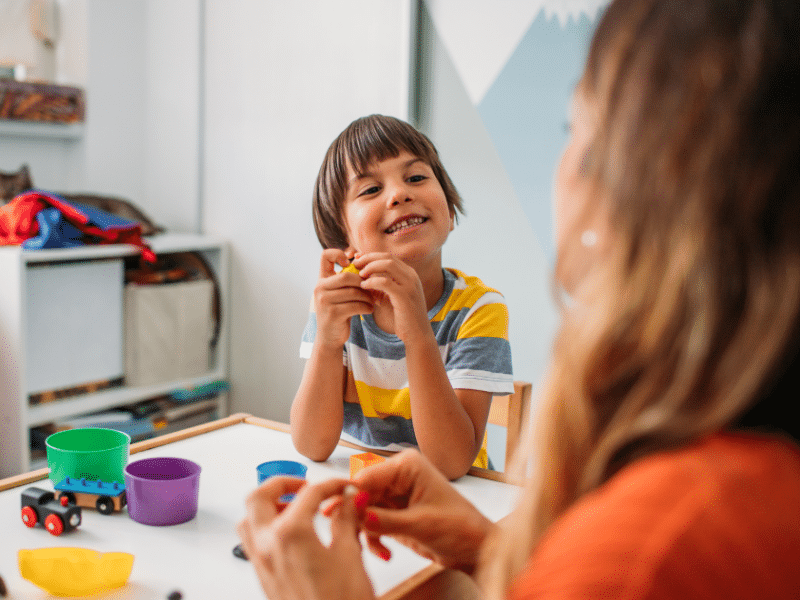
09 Dec COVID Lockdown and Child Development
The Impact of the COVID Lockdown on Child Development
The COVID-19 pandemic presented challenges to Australians unlike any seen in recent times. I relish the return to some of the ‘normalcy’ we had before. However, I also see signs that there may be longer-term impacts of COVID-19 lockdown on the development of children. Parents, educators and health professionals must be aware of these and act to address them.
Impact of staying at home
Exposure to rich experiences in varied environments is crucial to a child’s social and communication development. Parents worked hard to ensure children were safe and engaged during lockdowns. However, for two years, children missed out on meaningful opportunities for socialisation outside their homes, like birthday parties, visits to grandparents, sports, and play dates. Children need these experiences to practice social communication and learn new vocabulary. Research is clear that a child’s communication environment is a key predictor of education outcomes (Roulstone et al., 2011)
Screen-time
I admit: my children had far more access to screen time during the lockdown, and it seems our family was not alone. Children were required to use screens for education and social interaction. We were fortunate enough to access technology that made tele-education and tele-socialisation possible. However, opting for screen time instead of face-to-face social interactions with family may have further eroded access to social interaction.
Home-schooling
In talking to our clients, it seems that some, but not all, children thrived under home-schooling conditions during the COVID lockdown. Distance made it more difficult for many children, particularly those with a disability or children who did not have access to adequate technology. Some projections suggested that in the school years impacted by lockdowns, children would gain only 60% of the learning we expect in a typical school year (Kuhfeld et al., 2020). This is likely to more significantly impact children already behind academically and those with learning disabilities.
Access to therapy
The COVID Lockdown and social distancing reduced access to therapy for many children. Telehealth therapy was viable for some families but was challenging for many, including young children and children with complex disabilities. Some school-aged children were exhausted by full days at ‘Zoom school’ and could not cope with more time focusing on screens.
Masks
If babies and very young children cannot see the speaker’s face, they receive limited information required to develop speech, such as lip and tongue movement. Masks also obscure the sound quality from the speaker’s mouth. Children with hearing impairment may primarily rely on lip-reading to comprehend what is being said to them.
Should you be concerned about your child’s development?
- Know what to expect: Speech Pathology Australia has some great, parent-friendly information sheets on developmental milestones.
- Talk to your child’s educators: They can tell you what they have noticed and refer you to a professional for support.
- See a speech therapist. They will evaluate your child and pinpoint the areas where your child would benefit from support.
What can you do at home?
- Talk to your child. Get in the habit of narrating what you see/smell/hear/taste/feel/do/think.
- Avoid testing or questioning your child. Peppering children with questions about the names of things may make them less likely to engage, as they may feel pressured to have the correct response.
- Take 10. Identify 10-minutes each day that you and your child talk. Pick an activity that you both enjoy, e.g. bath time.
- Create a mini-photo journal. Reflect on the pictures and talk about what you did and how it made you feel.
- Be realistic about screen time. It is going to happen. Consider creating a family movie/TV time and set aside time to discuss it after watching.
- Notice opportunities to teach new words. Pick one new word per day. Include various word types. Actions, locations, and feelings are just as crucial as nouns.
For more tips, go to Speech and Language UK .
Concerned about your child’s communication development? Reach out to us!
Stay in the Loop
Stay in the Loop
Keep up with the latest from To the Moon & Back by subscribing to our newsletter and following us on social media.
Instagram: @tothemoonandbacktherapy
Facebook: To the Moon and Back Speech and Behaviour Therapy

Kristin Bayley is a speech therapist and behaviour consultant. She is a mum of two kids and the owner of To the Moon and Back Speech Therapy in St. Ives.


No Comments